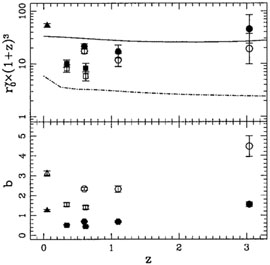


6.3. Spatial clustering and its "evolution"
The LBGs at z ~ 3 are characterized by strong spatial clustering,
with a co-moving
correlation length of ~ 3-4h-1 Mpc for a low matter
density ( 0 = 0.2)
Universe. This
is comparable to the clustering of present-day spiral and IRAS galaxies,
and a factor of
0 = 0.2)
Universe. This
is comparable to the clustering of present-day spiral and IRAS galaxies,
and a factor of
 2 smaller than that of
present-day ellipticals.
2 smaller than that of
present-day ellipticals.
A simple comparison of the observed clustering properties with the expected clustering of a suitably normalized CDM density field, as shown in Figure 11, shows that, in the context of such models, the LBGs must be substantially biased with respect to the dark matter, with higher bias required in models with higher matter density. As discussed above, the strong clustering and the large bias of the Lyman-break galaxies are consistent with biased galaxy formation theories and provide additional evidence that these systems are associated with massive dark matter halos.
One might be tempted to try to fit the Lyman break galaxy clustering
properties onto
a general evolutionary sequence for galaxy clustering versus cosmic
epoch. Figure 11
shows the galaxy clustering strength measured from various redshift
surveys, including
the LBGs, as a function of redshift. To quantify the clustering strength
we have used the function
r 0
x (1 + z)3, where now r0 is in
proper coordinates. The figure also shows the
corresponding plot of the bias derived using the CDM mass correlation
function, which
we have computed using the non-linear code for the evolution of the
power spectrum
by Peacock (1997).
We used the shape parameter
0
x (1 + z)3, where now r0 is in
proper coordinates. The figure also shows the
corresponding plot of the bias derived using the CDM mass correlation
function, which
we have computed using the non-linear code for the evolution of the
power spectrum
by Peacock (1997).
We used the shape parameter
 * = 0.25 and normalized the power
spectrum to
* = 0.25 and normalized the power
spectrum to  8 = 1.0
for the open model and
8 = 1.0
for the open model and
 8 = 0.5 in the
Einstein-de Sitter case. The
error bars have been computed by propagating the errors in the measure
of the correlation
length, but it is clear that the dominant uncertainty is in the choice
of normalization of the theoretical curve.
8 = 0.5 in the
Einstein-de Sitter case. The
error bars have been computed by propagating the errors in the measure
of the correlation
length, but it is clear that the dominant uncertainty is in the choice
of normalization of the theoretical curve.

|
Figure 11. Top. The strength of galaxy
clustering as a function of redshift. The continuous
solid and dashed lines are the expectations from the CDM theory with
|
As Figure 10 suggests, the
variations in the value of the "effective" bias from sample to
sample complicate the interpretation of the apparent evolution of galaxy
clustering as due
to the gravitational growth of structures, preventing us from deriving
information on the
clustering evolution of the mass. For example, the data show that the
traditional power-law
model  (r, z) =
(r, z) =
 0(r)
x (1 + z)-(3+
0(r)
x (1 + z)-(3+ ) used to describe the gravitational evolution
of clustering
(Peebles 1980)
is not a good representation for any value
of
) used to describe the gravitational evolution
of clustering
(Peebles 1980)
is not a good representation for any value
of  over the
redshift interval 0
over the
redshift interval 0  z
z  3. In fact, it
is clear from N-body simulations (e.g.,
Brainerd & Villumsen 1994;
Bagla 1997)
that the behavior of the clustering of halos, as opposed
to that of the overall mass, will have a non-trivial dependence on
redshift that is not
accounted for in the "
3. In fact, it
is clear from N-body simulations (e.g.,
Brainerd & Villumsen 1994;
Bagla 1997)
that the behavior of the clustering of halos, as opposed
to that of the overall mass, will have a non-trivial dependence on
redshift that is not
accounted for in the " "
models. When one also notes the uncertainties in the way in
which dark halos are effectively sampled in any given redshift survey,
we question the
ultimate usefulness of fitting values of this parameter to the results
of redshift surveys over substantial redshift baselines.
"
models. When one also notes the uncertainties in the way in
which dark halos are effectively sampled in any given redshift survey,
we question the
ultimate usefulness of fitting values of this parameter to the results
of redshift surveys over substantial redshift baselines.
Our results emphasize that the interpretation of apparent "evolution" of the clustering properties of galaxies in deep surveys, through either angular clustering analyses (e.g., Efstathiou 1995, Brainerd et al. 1995, etc.) or with comprehensive redshift surveys (e.g., Carlberg et al. 1997, Le Fèvre et al. 1996), cannot be directly interpreted as a reliable measure of the overall growth of structure. In a typical survey limited by apparent magnitude, the mix of galaxy types and the relative sensitivity of the survey to stellar mass, star formation rate, and bolometric luminosity (and the complicated manner in which these quantities are related to overall galaxy mass) will be strongly redshift-dependent. It is apparent now, if it has not always been, that the clustering properties of galaxies at moderate to high redshift cannot be used as a cosmological tool unless one is prepared to simultaneously understand where galaxies form and how they evolve relative to the underlying distribution of dark matter - cosmology and galaxy formation cannot be understood independently in this context.